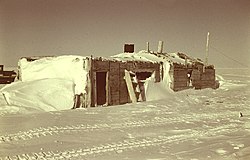Leffingwell Camp Site
Leffingwell Camp Site | |
Alaska Heritage Resources Survey
| |
 Sod house at the Leffingwell Camp Site (1949) | |
| Location | On Flaxman Island, about 58 miles (93 km) west of Kaktovik |
|---|---|
| Coordinates | 70°11′07″N 146°03′10″W / 70.1852°N 146.05287°W |
| Area | 10 acres (4.0 ha) |
| Built | 1906 |
| Built by | Anglo-American Polar Expedition |
| NRHP reference No. | 71001093[1] |
| AHRS No. | XFI-002 |
| Significant dates | |
| Added to NRHP | June 21, 1971 |
| Designated NHL | June 2, 1978[2] |
| Designated AHRS | January 15, 1971 |
The Leffingwell Camp Site, on Flaxman Island, 58 miles (93 km) west of Barter Island on the Arctic Coast of Alaska, was used by polar explorer and geologist Ernest de Koven Leffingwell on his pioneering Anglo-American Polar Expedition of 1906–1908, which aimed to explore the Beaufort Sea. The expedition's ship, the Duchess of Bedford, was allowed to become locked in ice which eventually destroyed it.[3]
The camp site was chosen before the ship was locked in ice, and was not merely the nearest landfall. The site was used by Leffingwell over several years, beyond the end of that expedition.
Leffingwell created the first accurate map of a section of Alaskan coastline. He was the first to scientifically describe permafrost and to pose theories about permafrost which have largely proven true. He accurately identified the oil potential of the area, including assessing that it was not, in his day, technologically or economically feasible to develop it.[3]

Following the destruction of the Duchess of Bedford, Leffingwell "returned to civilization in the fall of 1908, as the guest of Capt. George B. Leavitt."[4] Leffingwell subsequently named Narwhal Island for the name of Capt. Leavitt's vessel, the steam New Bedford, Massachusetts-based whaler Narwhal, and bestowed the name of the Maine-born Captain,[5] who married an Inuit woman and settled at Barrow, on Leavitt Island off the Alaska North Slope.[6]
The historic integrity of the camp was diminished in the 1930s when some structure was removed by a salvager.
The camp was added to the National Register of Historic Places in 1971[3] and was declared a National Historic Landmark in 1978.[2]
See also[edit]
- List of National Historic Landmarks in Alaska
- National Register of Historic Places listings in North Slope Borough, Alaska
References[edit]
- ^ "National Register Information System". National Register of Historic Places. National Park Service. January 23, 2007.
- ^ a b "Leffingwell Camp Site". National Historic Landmark summary listing. National Park Service. Archived from the original on May 11, 2011. Retrieved January 5, 2008.
- ^ a b c Susan Morton (September 18, 1987). "National Register of Historic Places Inventory-Nomination: Leffingwell Camp" (pdf). National Park Service.
{{cite journal}}: Cite journal requires|journal=(help) and Accompanying 12 photos from 1909, 1971, 1975. (3.47 MB) - ^ The Canning River Region, Northern Alaska, Ernest K. Leffingwell, Professional Paper, United States Geological Survey, Government Printing Office, Washington, D.C., 1919
- ^ Whaling captain and arctic explorer George B. Leavitt was the son of George W. Leavitt and his wife Helen E. (Greene) Leavitt, and was born in Portland, Maine.[1]
- ^ Narwhal Island, cLocations Archived 2011-07-08 at the Wayback Machine



